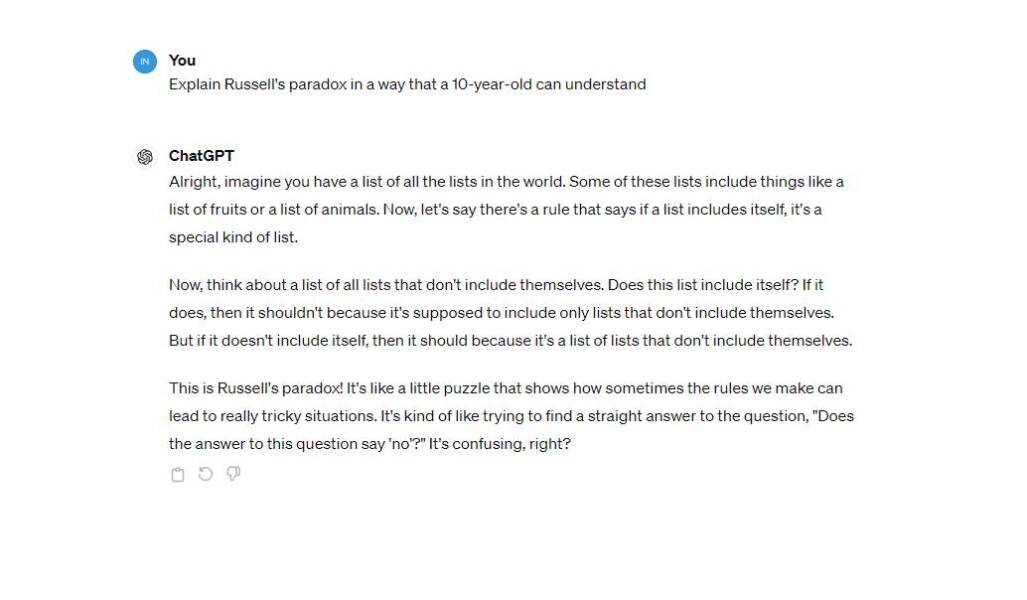Although ChatGPT is already known by most internet users, many users still do not master the basic and very useful prompts in their routine. OpenAI’s artificial intelligence (AI) chatbot can provide feedback on texts and mathematical tasks, translate articles with context and even offer recommendations on what to eat or watch. To demystify these commands, TechTudo listed seven essential prompts that all users should know. Check it out below.
7 ChatGPT commands everyone should know
1. Simplify information
Learning about complex subjects requires complex reading, but artificial intelligence can give a “little help” to facilitate learning. Textual commands “Explain [insert topic] in a simple way” and “Explain [insert topic] in a way that a 10-year-old child understands”, for example, work very well on ChatGPT. This way, it is possible to guarantee that OpenAI’s AI will use a simplified language and offer easy-to-understand examples.
In the image below, the AI was asked to explain Russell’s Paradox to a child. She chose to make an analogy with a toy box. Furthermore, note that the language used by the chatbot is simple, with easier words, as is normally used in a dialogue with children.
2. Generate list of ideas and suggestions
Anyone who works creatively knows that there are days when ideas simply don’t appear. Luckily, ChatGPT can act as an assistant during these periods, generating lists with suggestions for all types of topics. You can get decoration ideas for a party, title options for an article, list of items needed on a trip, among others.
The more specific the textual command, the better the recommendations created by the AI. For example, if you want to obtain a shopping list for a party, inform the chatbot about the type of party, whether it will be during the day or at night, whether there will be children present and other details. In the example below, ChatGPT was asked to create a food list for an outdoor children’s party with vegetarian and dairy-free options. The tool generated eight categories and, in each of them, brought alternatives that fit into the restricted diets established in the command.
3. Summarize text
If you are looking to summarize a text or make a long document easier to read, simply paste the text into the prompt and enter how you want the summary to be done. You can ask, for example, that ChatGPT gathers key information in a list format or that the tool only includes relevant data.
Another good example would be asking the chatbot to summarize a Wikipedia article. For example, a text of six paragraphs can be transformed into seven topics, each of which contains the main information about the subject organized in a list format. For longer texts, it is interesting to set a limit for the summary, if you want something shorter.
4. Edit text
ChatGPT can also be a text editing tool, capable of correcting grammar and spelling, changing the writing style and even adapting it for reading by a specific group of people. To do this, simply create a textual command that identifies the changes you want the artificial intelligence to make and then paste the text. Some examples of prompts could be “leave an email to HR at a more formal or professional company“, “change the writing to sound natural” or even “adapt a text so it can be read by younger people” .
In this textual command, to transform writing an email into something more professional, ChatGPT made some word changes to more formal alternatives, improving the language. Additionally, the AI added a thank you paragraph at the end, which is usually a good practice when sending this type of message.
5. Translate into another language
Another basic function of ChatGPT concerns text translations. The chatbot is capable of changing the language of articles in a few seconds, simply by copying the fragment and inserting the new language. On cell phones, the software also has a function that responds out loud, which facilitates communication. Additionally, the chatbot can also translate from specific contexts. Examples of prompts are “Write this sentence in [choose language]” or “Translate [text] into English in an executive language.”
6. Choosing what you will eat or watch
Similar to the suggestions function, but in a broader context, ChatGPT can also be used to get recommendations, such as movies, music, restaurants and more. You can also inform your tastes so that the tool’s suggestions are personalized and more assertive.
In the example below, the function was tested with a textual command that asks for a horror movie recommendation. To narrow down the tool’s field of choice, a period was chosen — between 1999 and 2024 — and three horror films were selected for ChatGPT to recommend something similar. Furthermore, the tool was asked to explain the reason for the recommendation, which helps to understand whether the answer is aligned with the user’s search or not. The AI recommended the film “The Conjuring” and presented some similarities that this film has with the examples given.
7. Receive feedback
Just as ChatGPT can correct texts, the tool also offers feedback, allowing the user to make improvements on their own and learn from mistakes made. The chatbot’s role in this role extends to different types of feedback, such as pointing out improvements in different text formats, showing the best way to get an answer to a school assignment, showing the highs and lows of a project or just advice related to problems. personal.
In any case, it is important to contextualize the tool regarding the type of feedback it should deliver. In this test, we send a correctly answered mathematical exercise to receive feedback from ChatGPT.
TechnologyHQ is a platform about business insights, tech, 4IR, digital transformation, AI, Blockchain, Cybersecurity, and social media for businesses.
We manage social media groups with more than 200,000 members with almost 100% engagement.














































